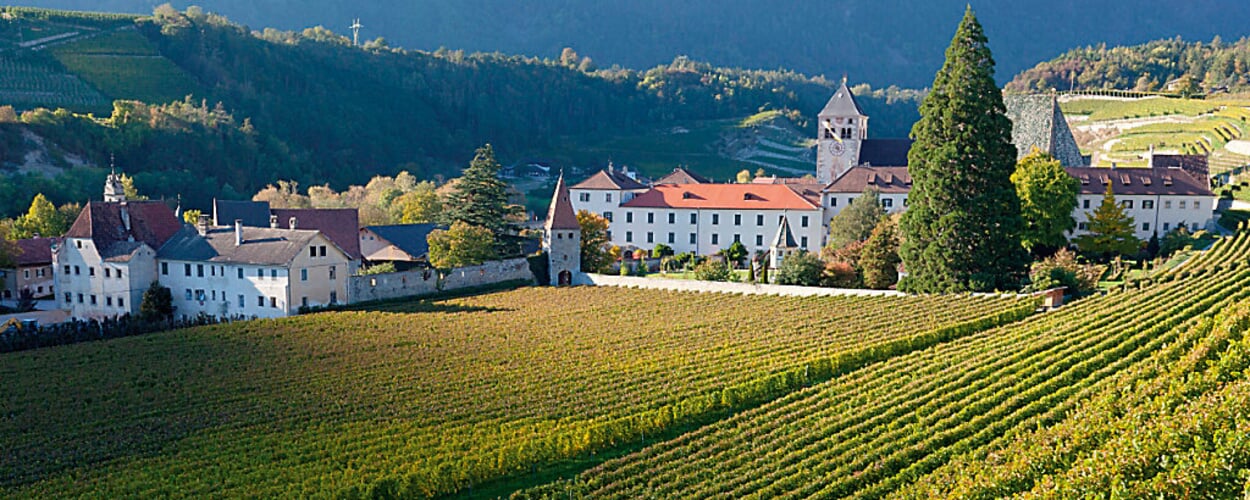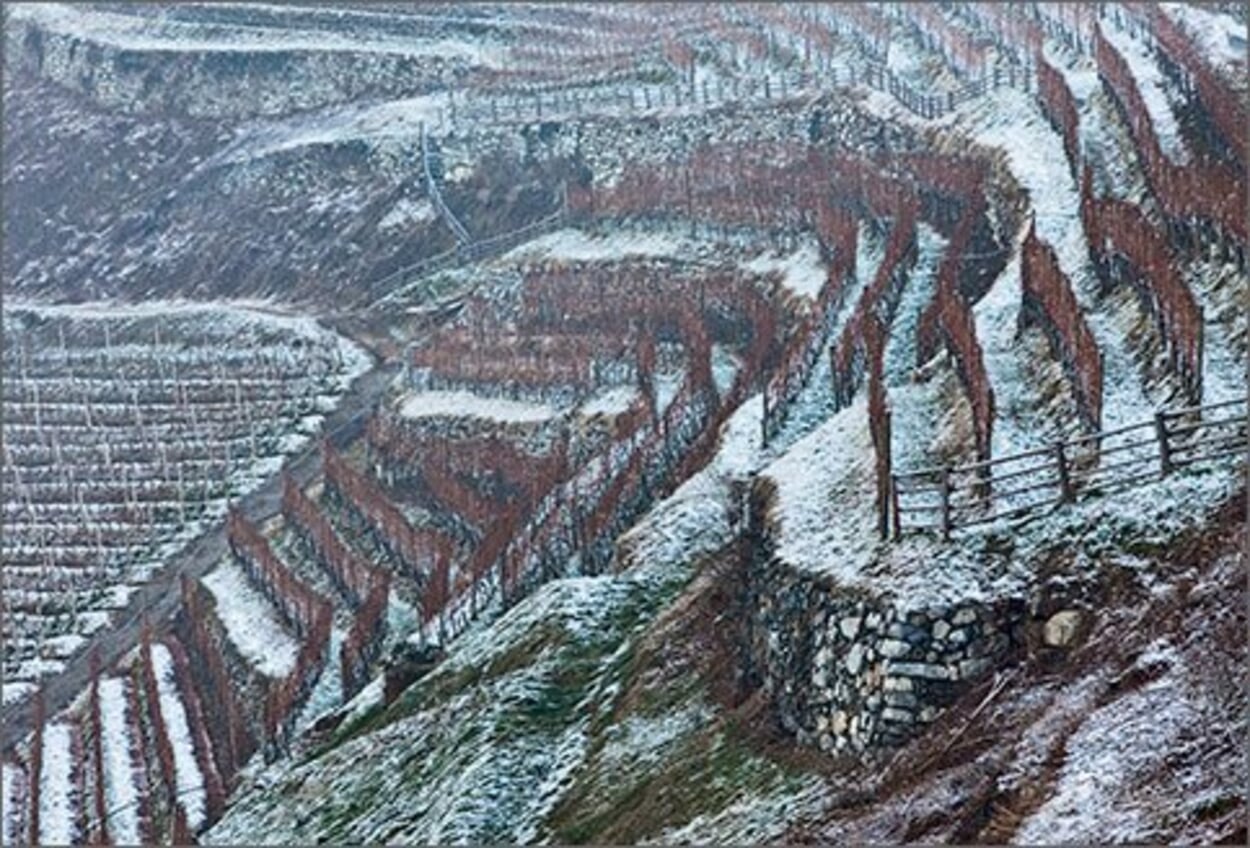Gutes aus Klöstern
Terroir. Kloster Neustift
Once forbidden, now praised: How I discovered the Kerner on its terroir
When I began my assignment as abbey administrator on July 1, 1987, pretty much the first thing I did was inspect the winery. Cellar master Hans Sigmund received me very kindly and explained to me with joy that all the wine barrels were already empty and everything had already been bottled. Except for a small barrel (2,000 liters); there was a "forbidden" (not permitted) wine inside. When I asked what it was and whether I could taste the wine, Hans explained that he would like to taste the wine with me and had therefore kept it separately. The wine is the Kerner, a cross between Riesling and Trollinger, which was bred in 1929 in Weinsberg and was actually intended for deep, almost flat locations in Germany. There, however, the matter turned out very badly, because in these basically already poor wine-growing areas the Kerner vines were loaded with far too high quantities and therefore a wine of very modest quality, namely only blend wine quality, was produced. So I was a little surprised that he had kept just this wine, and my expectations were not exactly enthusiastic. But then we tasted the Neustifter Kerner, and I was blown away by its freshness, fruit and race. How could this be possible? Well, in conversation with Hans, I realized what had led to this surprising and high quality: the steep sites, the mountain climate with the strong temperature fluctuations between day and night, the poor, light glacial moraine soils in the Eisack Valley around the monastery, and the very low yields really bring out the characteristics of this variety. For me, it was a terrific start to my new work for the monastery. We now learned more about the special requirements of the Kerner and learned about its particular winter hardiness. This was of course particularly interesting for our area, since the same is the northernmost cultivation area of Italy, the vineyards are also very high (600 to 900 m) and therefore the temperatures in winter can be very low and also always cause great damage to the vines. Here it really needs a particularly pithy vine. To really understand the Neustift peculiarities, one must go back to the Ice Age. At that time, in the Wipp and Eisack valleys, an ice massif up to 1,000 meters thick piled up, which on its very leisurely, but unstoppable journey down the valley, planed, crushed and mixed a vast amount of rock material from the parent rocks and pushed the resulting masses of debris in front of it and up the slopes. When the glaciers melted at the end of the Ice Age, a wide variety of formations came to light. This is how the Bressanone basin came into being, where the debris forms a particularly protected arena, open to the south, shielded from the north, with steep slopes throughout and gravelly, easily heated soils. Here, very close to the main Alpine ridge - the Brenner Pass is only about 30 km away as the crow flies - a microclimate developed in which the grapevine can survive and, if certain "rules of the game" are observed, even flourish very well. In any case, we immediately sought the appropriate official approvals and at the same time tested and studied the variety on site. Of course, it also likes good locations, but it plays its trump cards especially where the cold accumulates in winter; because the shoots of the Kerner lignify about a month earlier than those of all other varieties, and so the resistance to cold is also significantly higher. After the DOC recognition in 1992 (Südtiroler Eisacktaler Kerner DOC - QbA), things went from strength to strength. The wine impressed at tastings all over the world, turned out to be a very flexible food companion, can age for many years and is today the most awarded and now also in terms of volume the most important variety of our house. Bred for the plains, the Kerner has found its true home, its real terroir, however, high up on the mountain. Urban von Klebelsberg, administrator of the Augustinian Canons' Monastery of Neustift, South Tyrol.
The Neustift Microcosm
At Kloster Neustift the vineyards start at 600 m and climb up to almost 900 m. The climate here is perfect for the fruit-driven white wine varieties. They feel very comfortable here, because they basically do not like it too hot and need the interplay between warm days and cool nights. This allows the aromas to develop particularly well, and the stimulating acidity is also maintained. The coordination of variety and site is complex, because as soon as the orientation, the slope or the altitude of a vineyard changes, the microclimate changes so much that only by changing the variety can the potential of these small sites be optimally exploited. A good example of this is the vineyard behind the Neustift Collegiate Church, where four different varieties are grown on a surface area of only about 5,000 m²: In the lowest part, where a lot of cold air collects behind the monastery wall in winter, there is Kerner, which is particularly frost-resistant. Just up the slope, in the most sheltered position, is the Sylvaner, which is very sensitive to winter winds. On the steepest and warmest slope, the sun-hungry Gewürztraminer thrives. The Pinot Grigio feels really comfortable in areas where it is a bit too windy for the Sylvaner. It is a very dense grape, and in autumn it is therefore very important to "blow off" the morning dew as soon as possible, otherwise there is an increased risk of rot. Thus, it should not be too close to steep slopes sheltered from the wind. The largest Pinot Grigio area is therefore located south of the monastery, just behind the winery.
Architectural symbolism. The macrocosm.
The most idiosyncratic vanishing points and lines of meaning lead the visitor and pilgrim step by step into the world of the Brixen canons' monastery of Neustift. Since 1142 this unusual monastery building in the valley of the Eisack has grown into what still fascinates us today. A few steps before the monastery, the guest has already arrived where the longing of medieval man went, as far as earthly things were concerned: in Rome, the head of the whole world. How? A small but unmistakable replica of Castel Sant' Angelo, the Castle of the Angels, welcomed him and still does. Above the entrance to this defiant former pilgrims' hospice, the Archangel Michael examines the souls on the scales of justice: surely an invitation to inner examination and preparation. But this was apparently not enough for the later Baroque man with his cosmic-emblematic thinking. The octagonal Brunnen in the prelate's courtyard bears witness to this. The spandrels of its canopy are painted with representations of the Seven Wonders of the World. Of course, the eighth panel could not be left empty, so what could be more natural than to decorate it with a view of the monastery itself, and not without sense: on the opposite side we find a depiction of the Hanging Gardens of Babylon! And this is how the Brunnen was executed, as a miraculous macrocosm shifted inward, full of self-confidence, but at the same time with playful nuances. Whoever now passes through the prelature finds himself abruptly in front of the basilica and experiences a further elevation of soul and spirit, beyond the earthly into the spirituality of the house of God. In its baroque decoration it is filled with innumerable sensuous metaphors of the supernatural. But even here, the Neustift world is not yet over.



